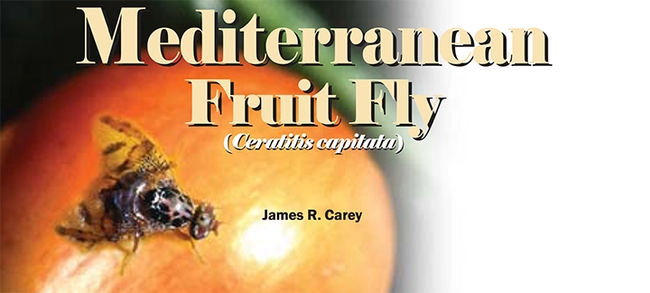- Author: Kathy Keatley Garvey
It's the Fourth of July and what better time to post images of the aptly name "soldier beetles" than today.
These insects (family Cantharidae) resemble the uniforms of the British soldiers of the American Revolution, which is apparently how their name originated. They're also called "leatherwings" in reference to their soft, leatherylike wing covers.
Like lady beetles, aka ladybugs, these soldier beetles make short work of aphids and other soft-bodied insects. We've seen them devour so many aphids on our plants that they should be awarded the Aphid Belt, similar to Joey Chestnut's famed Mustard Belt.
Indeed, soldier beetles are eating machines, just like Joey.
Wikipedia describes Joey Chestnut (who, by the way, grew up in Vallejo, Solano County), as an "American competitive eater" ranked No. 1 in the world by Major League Eating. In addition to hot dog-eating contests, Chestnut has won contests devouring pizza, wontons, chicken wings, and corned beef sandwiches. And even poutine (french fries and cheese curds, topped with brown gravy).
No aphids, yet, though. Not even sprinkled on pizza slices.
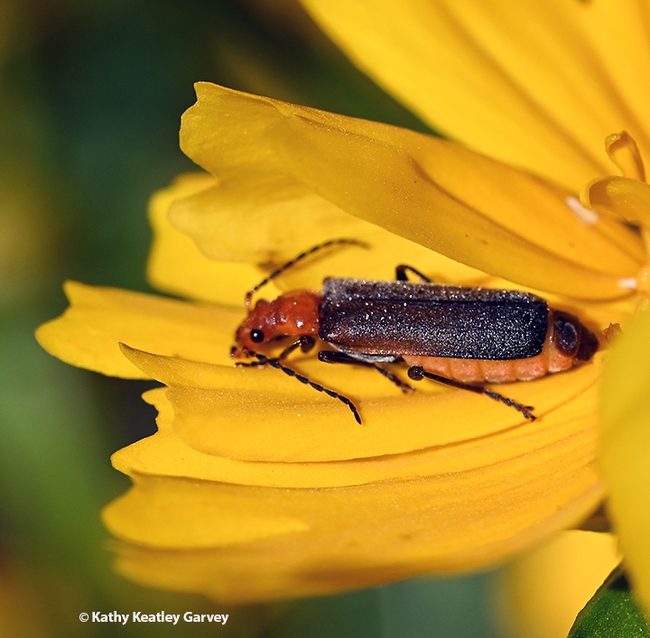
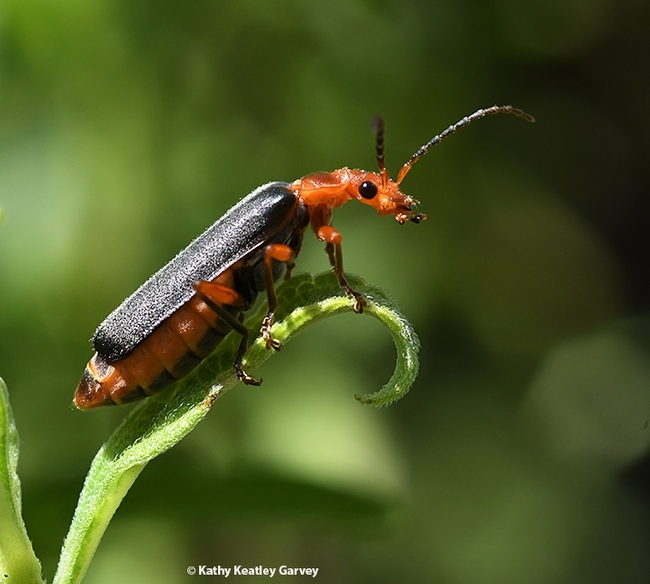
- Author: Kathy Keatley Garvey
247 years!
The seven faculty members honored at the UC Davis Department of Entomology and Nematology's recent retirement luncheon amassed an amazing 247 years of service:
- UC Davis distinguished professor James Carey, 44 years, faculty member since 1980. He retired in June.
- UC Davis distinguished professor Richard Karban, 42 years, faculty member since 1982. He retired in June.
- UC Davis distinguished professor emerita Lynn Kimsey, 35 years, faculty member since 1989. She retired Feb. 1, 2024.
- Robert Kimsey, adjunct professor, 35 years, faculty member since 1989. He retired in June
- UC Davis distinguished professor Jay Rosenheim, 34 years, faculty member since 1990. He retired in June.
- UC Davis distinguished professor Diane Ullman, 29 years, faculty member since 1995. She retired in June.
- Sharon Lawler, professor emerita, 28 years, faculty member since 1995. She retired in January 2023.
Read about them on our UC Davis Entomology and Nematology website, with links to individual stories. You may have interacted with one or more of them through their research, teaching or public service.
As molecular geneticist and physiologist Joanna Chiu, professor and chair of the department, said prior to the retirement luncheon: “Our retiring faculty will leave behind some very big shoes to fill. “They have set the bar very high for all of us with their passion to lifelong scientific exploration, perseverance to achieve intellectual and mentoring excellence, and dedication to the department, UC Davis, and external stakeholders. We are so proud to call them colleagues and mentors and they will no doubt continue to inspire us to carry on their legacy. It is with our most sincere appreciation that we wish all of them the best in their new endeavors and adventures in this next chapter of their lives."
247 years of service!
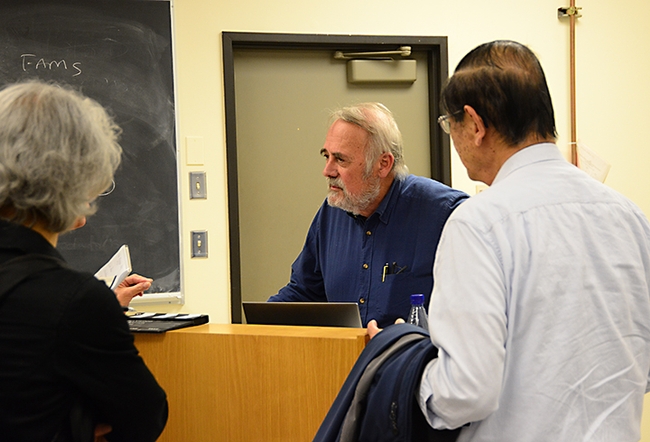
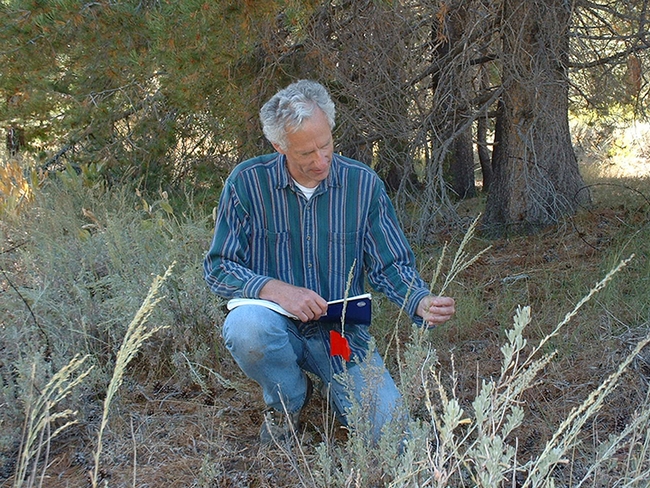
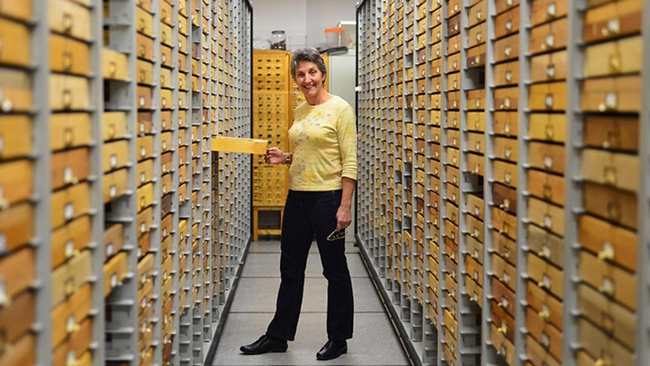

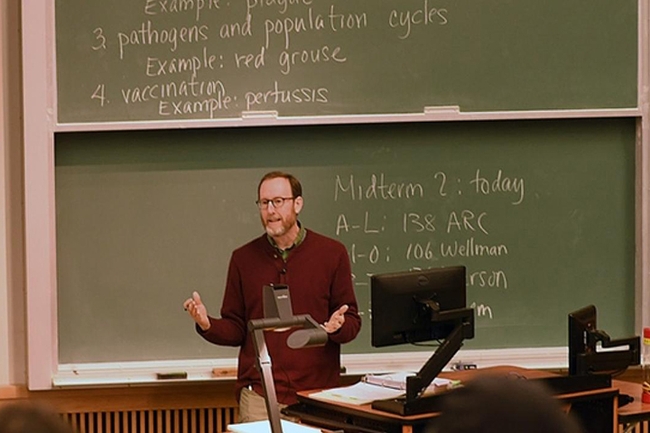
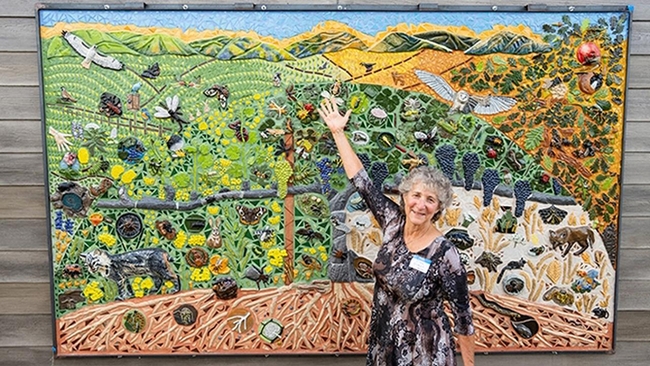
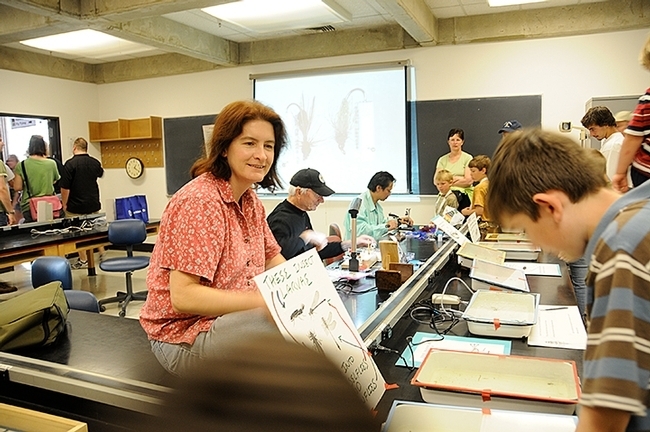
- Author: Kathy Keatley Garvey

But such is the case with UC Davis distinguished professor James R. Carey.
A member of the UC Davis Department of Entomology faculty since 1980, he was one of seven retiring or retired faculty members honored at a retirement event on June 11 at the UC Davis Alumni Center.
"A giant in our department" and "a scholar in every sense of the word."
That's how UC Davis distinguished professor emeritus Frank Zalom characterized him.
Carey, who holds a joint appointment as a senior scholar in the Center for the Economics and Demography of Aging at UC Berkeley, is internationally known not only for his research in insect biodemography, mortality dynamics, and insect invasion biology but for his groundbreaking teaching program that centers on the strategic use of digital technology.
He is retiring this month.
In his five-minute allocated speech, Zalom, an integrated pest management specialist and a past president of the Entomological Society of America (ESA), noted that Carey developed much of his highly cited work on cohort life tables early in his career. "This led to his highly regarded work on biodemography and longevity that are widely recognized across many scientific disciplines beyond entomology. He is a scholar in every sense of the word."
"Jim's career long attention to invasive species, and in particular, his challenges to the dogmatic approach taken by regulatory agencies to their detection and eradication," Zalom said. "He has framed his challenges in the concept of invasion biology. He has urged the agencies to base their approaches on the entirety of available data and has taken it upon himself to thoroughly compile and analyze data on the occurrence of tephritid fruit flies in the United States as a prime example."
"Jim has been one of the giants of our department during the last 44 years, and I hope that he will continue to engage in his intellectual pursuits as an emeritus professor," Zalom concluded.
Highly honored by his peers, Carey is a fellow of four professional societies: ESA, American Association for the Advancement of Science, California Academy of Sciences, and the Gerontological Society of America. When ESA elected him a fellow in 2011, the organization described him as "the world's foremost authority on arthropod demography" and that he "is the first entomologist to have a mathematical discovery named after him by demographers – the Carey Equality — which set the theoretical and analytical foundation for a new approach to understanding wild populations."
Carey holds two degrees from Iowa State University: a bachelor's degree in fisheries and wildlife biology (1973), and master's degree in entomology (1975). He received his doctorate in entomology from UC Berkeley in 1980, the same year he joined the UC Davis faculty. As a doctoral student in 1978, he worked in the laboratories of population biologists Richard Lewontin and Richard Levins at Harvard University.
Carey is a former director (2003-13) of an 11-university consortium funded by the National Institute on Aging (NIH/P01) on the evolutionary ecology of lifespan. The 10-year, $10 million federal grant on “Aging in the Wild,” encompassed 14 scientists at the 11 universities.
Carey co-authored the book “Biodemography: An Introduction to Concepts and Methods” (Carey, J. R. and D. Roach. 2020; Princeton University Press), hailed as the “definitive textbook for the emerging field of biodemography, integrating biology, mathematics and demography.” To supplement the book, Carey created a free-access, video guidebook with a playlist of 175 separate presentations, subtitled in 300 different languages. It can be accessed on the UC Berkeley Population Sciences website at https://bit.ly/3FTge7u.
Carey earlier authored three books, Demography for Biologists (Oxford University Press 1993), "Longevity" (Princeton University Press, 2003), and Longevity Records: Life Spans of Mammals, Birds, Amphibians and Reptiles (Odense, 2000), as well as more than 250 journal articles and book chapters.
Internationally Recognized Teacher. An internationally recognized teacher, Carey was named a semi-finalist for the 2017 Baylor University Robert Foster Cherry Teaching Award (an international competition). He received ESA's Distinguished Teaching Award in 2014, after winning the 2014 distinguished teaching award from the Pacific Branch, ESA (PBESA). Another highlight was receiving PBESA's C. W. Woodworth Award in 2013. PBESA covers 11 Western states, plus parts of Mexico and Canada, and U.S. territories.
Carey developed a technological-savvy teaching program, a groundbreaking model for 21st Century instruction using short, concise videos. In so doing, he taught faculty, staff and students how to create succinct videos, and how to record seminars. All are geared toward ease of learning and increased knowledge retention.
Carey became interested in the use of digital technology in academia when he chaired the UC Academic Senate University Committee on Research Policy. He subsequently described a framework or “road map” for using video capture of seminars to increase research synergy across the 10 UC campuses. The University of California TV station, UCTV, then used this publication as a roadmap for creating the video platform, UCTV Seminars. The website has tallied more than 10 million seminar downloads.
Longevity Course. Carey taught an upper division undergraduate course titled "Longevity" (fall quarter and summer session), based on biodemographic concepts in both non-human species and humans. He also offered seminars and workshops on best practices in visualization concepts and presentation strategies, including a weeklong course annually to PhD fellows in Kampala, Uganda enrolled in the 9-university Consortium for Advanced Research Training in Africa (CARTA).
Another honor he received was the UC Davis Academic Senate's Scholarly Public Service Award. In the nomination package, his colleagues praised him for carving "impressive milestones in biodemography, research, teaching and outreach during his 40-year professional career, not only raising the profile of entomology nationally and internationally, but serving as an entomology ambassador to scientists in a wide range of disciplines, particularly demography and gerontology."
Some of his accomplishments:
One-Minute Entomology. Carey innovated the concept of the “one minute expert” by launching student-produced videos that are 60 seconds in length. He and UC Davis distinguished professor Lynn Kimsey (now emerita) engaged their students in producing more than 125 videos, and in the process, learning insect identification, succinct writing and speaking, best practices for slide presentation, peer review and teamwork.
How to Make an Insect Collection. Carey taught undergraduate and graduate students how to gather information and produce short videos for “How to Make an Insect Collection.” The award-winning project, considered by ESA as the best of its kind on the internet, includes a playlist of 11 short videos showing different aspects of insect collecting--from use of nets and hand collecting to pinning mounting and labeling.
Basics of Term-Paper Writing. His students have continually won the top awards at the UC Davis-sponsored Norma J. Lang Prize for Undergraduate Information Research in the category of Science, Engineering and Mathematics (SEM). One of his students has won first place in the SEM category in each of past five years. Five others have won either second or third place honors.
"A giant in the department, a scholar in every sense of the word."
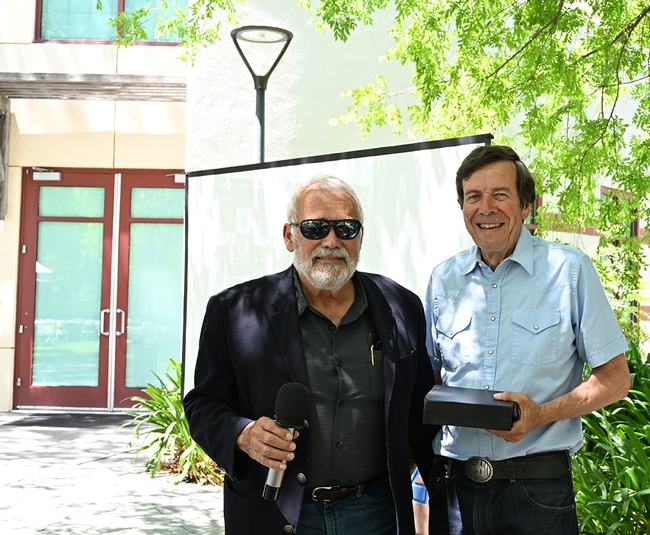

- Author: Kathy Keatley Garvey
If you missed UC Davis distinguished professor James R. Carey's well-attended seminar on "California's Fruit Fly Invasion: A 70-Year Struggle Nears Critical Mass," it's now online on YouTube.
His seminar, which took place June 3 in Briggs Hall, UC Davis, and on Zoom, drew global interest, stretching as far as Australia.
Carey pointed out that Callfornia has "the largest agricultural industry in the United States ($55 billion), is the fifth largest worldwide supplier of agricultural produces, grows more than 200 different crops, and "most fruit crops have been attacked by multiple tephritid species."
The California Department of Food and Agriculture (CDFA) reported that the first Mediterranean fruit fly (medfly) outbreak occurred on June 5, 1980, he said, and as of June 3, the state has detected 18 total species of fruit flies in 350 cities, amounting to 11,000 detections.
In his hour-long seminar, Carey presented an overview of the long-developing crisis, discussed lessons learned from analysis of fruit fly detection databases, and argued that "in order to have any chance at stemming this ever-rising tide, CDFA and the USDA urgently need to switch from their historic, ad hoc eradication strategy to a new one that is evidence-based and far more scientific."
In the closing moments, he asked "Why have oriental fruit fly outbreaks been occurring annually for the past 60 years in California?"
Because, he said, the fruit flies are "permanently established."
Carey, a 44-year member of the UC Davis faculty who is retiring in June, and a senior scholar in the Center for the Economics and Demography of Aging at UC Berkeley, researches insect biodemography, mortality dynamics, and insect invasion biology. He holds a doctorate in entomology from UC Berkeley (1980).
Carey served on the CDFA's Medfly Scientific Advisory Panel from 1987-1994, testified to the California Legislature "Committee of the Whole" in 1990 on the Medfly Crisis in California, and authored the paper "Establishment of the Mediterranean Fruit Fly in California" (1991, Science 258, 457).
He is a fellow of four professional societies: Entomological Society of America, the American Association for the Advancement of Science, the California Academy of Sciences, and the Gerontological Society of America. He is former director (2003-13) of a 11-university consortium funded by the National Institute on Aging (NIH/P01) on the evolutionary ecology of lifespan. He co-authored the book “Biodemography: An Introduction to Concepts and Methods” (Carey, J. R. and D. Roach. 2020; Princeton University Press) and authored the books, “Demography for Biologists (Oxford University Press 1993), Longevity (Princeton University Press, 2003), and Longevity Records: Life Spans of Mammals, Birds, Amphibians and Reptiles (Odense, 2000) as well as more than 250 journal articles and book chapters.
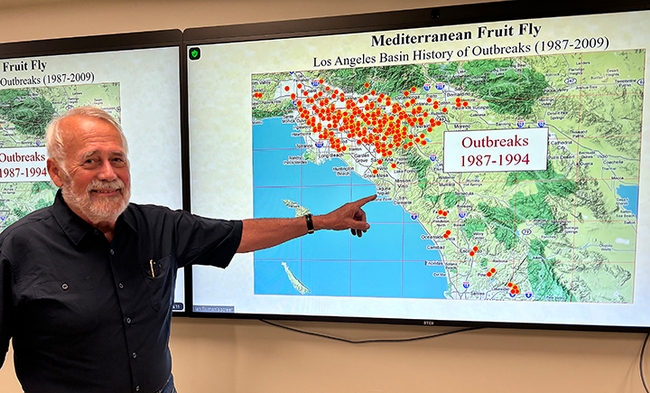
- Author: Kathy Keatley Garvey

Oh, there ain't no bugs on me
There ain't no bugs on me
There may be bugs on some of you mugs
But there ain't no bugs on me
You can hear it on YouTube.
UC Davis distinguished professor James R. Carey of the Department of Entomology and Nematology, drew national news media coverage in 1991 when he declared that the medflies are "established" here, that the "recurring outbreaks" are not caused by tourists continually bringing infested fruit to California in their airline baggage.
Today Carey says that California's fruit fly invasion is in "crisis mode."
The professor will present a Department of Entomology and Nematology seminar on "California's Fruit Fly Invasion Crisis" at 4:10 p.m., Monday, June 3 in Room 122 of Briggs Hall. It also will be on Zoom. The Zoom link:
https://ucdavis.zoom.us/j/9 5882849672.
"After seven decades of near-continuous outbreaks in scores of California cities, tephritid fruit fly invasions (e.g., Mediterranean, oriental, peach, and Mexican fruit flies) are reaching critical mass, with many of the annual eradication programs morphing into below-the-radar, never-ending fruit fly control programs," Carey says in his abstract. "Permanent establishment of any one of these tropical species has the potential to shut down the multi-billion dollar domestic and foreign markets for hundreds of California fruit and vegetable crops."
"I will present an overview of the long-developing crisis, discuss lessons learned from analysis of fruit fly detection databases, and argue that, in order to have any chance at stemming this ever-rising tide, CDFA and the USDA urgently needs to switch from their historic, ad hoc eradication strategy to a new one that is evidence-based and far more scientific."
Carey served on the CDFA's Medfly Scientific Advisory Panel from 1987-1994, testified to the California Legislature "Committee of the Whole" in 1990 on the Medfly Crisis in California, and authored the paper "Establishment of the Mediterranean Fruit Fly in California" (1991, Science 258, 457).
Carey is a fellow of four professional societies: the Entomological Society of America, the American Association for the Advancement of Science, the California Academy of Sciences, and the Gerontological Society of America. He is former director (2003-13) of a 11-university consortium funded by the National Institute on Aging (NIH/P01) on the evolutionary ecology of lifespan.
